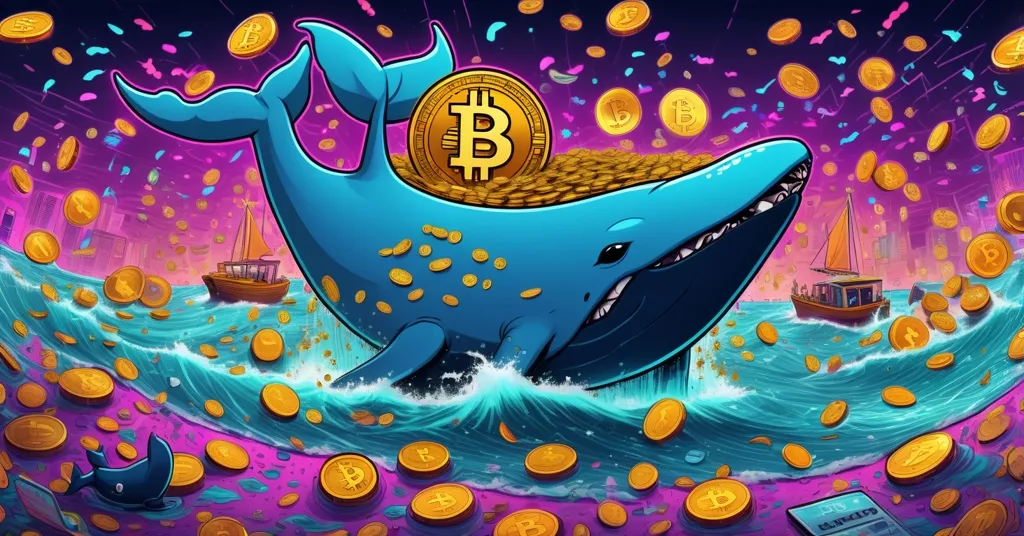Bitcoin Whales Sell Off, DOGE & FLOKI Thrive, $APEING Fuels Meme Coin Hype

Bitcoin Whales Cash In, DOGE and FLOKI Defy Odds, and $APEING Sparks Meme Coin Frenzy
Bitcoin’s biggest players are selling off chunks of their holdings, meme coin giants Dogecoin (DOGE) and Floki Inu (FLOKI) continue to ride waves of community passion, and a new contender, $APEING, is luring fast-acting traders with exclusive whitelist access. Let’s unpack the latest market moves, from calculated whale plays to the chaotic charm of meme coins, and what they mean for the future of crypto.
- Bitcoin Whales Selling: Late-cycle profit-taking by long-term holders sparks volatility, but it’s not a crash signal, per Glassnode.
- Meme Coin Strength: DOGE and FLOKI stand tall, powered by loyal communities despite market swings.
- $APEING Buzz: A new meme coin taps into rapid-fire trading hype with early investor perks, but risks loom large.
Bitcoin Whales: Profit-Taking or Panic?
Are Bitcoin’s heaviest hitters bailing out, or just playing a smarter game? Recent on-chain data from blockchain analytics firm Glassnode reveals significant sell-offs by Bitcoin whales—wallets holding massive amounts of BTC. But before you sound the alarm, understand this: it’s not a mass exodus. As Glassnode analysts note, this is a classic move by seasoned investors.
“This steady distribution comes from experienced holders, not a sudden mass exit.”
What’s happening here is late-cycle profit-taking. In simple terms, these whales are locking in gains after holding through Bitcoin’s rollercoaster price surges, often a sign we’re nearing the peak of a bull run or entering a consolidation phase. Think of it as cashing out chips at the casino after a hot streak—not a sign the house is collapsing, but a calculated step to secure winnings. Glassnode’s metrics, like the HODL wave (which tracks how long coins have been held), show older coins moving to exchanges now, confirming these are long-term holders selling, not panic-driven newcomers.
Historically, we’ve seen this before. During the 2017 bull run, whales sold off at peaks around $20,000, triggering dips before Bitcoin stabilized and later soared again. Same story in 2021—large sell-offs preceded a correction, but the market absorbed the pressure as new buyers entered. Today, while these moves can spark short-term Bitcoin price volatility, they don’t necessarily herald a bear market. On-chain data also shows the “spent output profit ratio” (SOPR), a measure of whether coins are sold at a profit or loss, trending high for long-term holders—another clue they’re simply taking profits, not fleeing.
Still, let’s not gloss over the impact. When whales dump large volumes, it can spook retail investors and trigger cascading sell-offs, especially in a market already jittery from macroeconomic pressures like interest rate hikes or regulatory noise. On the flip side, these dips often create buying opportunities for those with dry powder. Bitcoin remains the bedrock of crypto, often dictating sentiment for altcoins and the broader decentralized finance (DeFi) space. Its whale activity also raises questions about centralization—do a handful of big players hold too much sway over a system meant to be trustless? For now, the takeaway is clear: volatility is baked into Bitcoin’s DNA. Keep an eye on exchange inflows and market depth to see if this selling pressure eases or escalates. This isn’t doom—it’s just the game.
Meme Coin Magic: DOGE and FLOKI’s Unshakable Grit
While Bitcoin whales play chess with the market, meme coins like DOGE and FLOKI are playing a different game—one fueled by raw passion and viral energy. Dogecoin, the OG meme coin born as a joke in 2013, still barks loud at $0.1623 with a staggering market cap of $24.63 billion. With 151.76 billion tokens in circulation, DOGE hit its all-time high of $0.7376 in May 2021, largely thanks to social media hype and endorsements from figures like Elon Musk. Remarkably, 85% of holders remain bullish despite wild swings, a testament to its cultural status as a middle finger to traditional finance. DOGE isn’t about cutting-edge tech or utility—it’s a digital Shiba Inu that thrives on community loyalty and pure sentiment.
Floki Inu, themed around Viking lore and named after Musk’s pup, is another underdog with bite. Trading at $0.000055 with a $523 million market cap, FLOKI ranks #100 on CoinMarketCap. Its peak of $0.000346 in June 2024 captured meme coin mania at its finest, and 83% of holders are still riding the wave with optimism. Beyond memes, FLOKI pushes into NFTs and ecosystem projects like educational platforms, aiming for a bit of substance. But make no mistake—its fuel is community, not code. Social media metrics paint the picture: FLOKI boasts over 400,000 Twitter followers and active Telegram groups, while DOGE’s subreddit and Twitter engagement often outpace many “serious” altcoins.
So why do these tokens endure while countless others fade? It’s the power of people over fundamentals. Meme coins tap into a cultural zeitgeist—DOGE as the everyman’s crypto, FLOKI as a quirky Viking crusade—that keeps fans invested emotionally, even when wallets bleed. Trading volume often spikes on news or tweets, not tech upgrades. They’ve also become gateways for retail investors new to crypto, with DOGE alone onboarding millions during the 2021 bull run per wallet activity data. In a space where Bitcoin whales can shake confidence, these tokens prove community momentum can defy gravity.
But here’s the devil’s advocate take: are meme coins a bubble waiting to burst? DOGE’s unlimited supply means inflationary pressure—10,000 new coins mined per minute, diluting value over time. FLOKI faces a crowded field of meme rivals, and if hype fades, so might relevance. Regulatory scrutiny is another shadow; governments eyeing “speculative assets” could crack down, especially if scams in this niche multiply. While community strength is real, it’s not bulletproof. Long-term viability hinges on evolving beyond jokes—whether through utility or sustained cultural impact. For now, DOGE and FLOKI are scrappy survivors, but betting on them requires stomach for chaos.
$APEING: Hype Machine or Hazard Zone?
Enter $APEING, the latest meme coin contender revving up the hype engine. Built on the slang term “apeing”—jumping into an investment headfirst, often driven by gut instinct or social media buzz rather than research—this project targets traders who live for speed and viral trends. It’s chasing the lightning-in-a-bottle success of DOGE and FLOKI, banking on community fervor and quick flips. For a deeper look at how Bitcoin whales stir the market while DOGE, FLOKI, and $APEING shine, the meme coin landscape is heating up with opportunity and risk. What’s generating buzz is its whitelist access for early investors, a tactic increasingly popular in token launches. Whitelisting is like snagging a VIP pass before the crowd rushes in: you get pre-approved to buy tokens at lower prices, secure your allocation, and dodge the launch-day madness of gas wars (sky-high transaction fees on networks like Ethereum when demand spikes).
The appeal is obvious. Early movers can position for huge gains if the token pumps post-launch, avoiding the chaos of public sales where bots and scalpers often dominate. But let’s cut the BS—this is a high-stakes roll of the dice with no guarantee of anything but hype, and potentially heartbreak. Meme coin launches are a notorious minefield. For every success, there are dozens of rug pulls—projects where devs vanish with funds after a hyped launch. $APEING’s lack of transparency raises neon red flags. Is there a public team? A whitepaper? An audit? Without these, it’s blind faith at best, a scam at worst. Compare it to flops like Squid Game Token in 2021, which soared on hype before collapsing 99.99% overnight as insiders cashed out. History doesn’t lie—newcomers get burned when FOMO overrides caution.
For beginners tempted by the thrill, here’s hard advice: start small, dirt cheap small. Track social chatter on Twitter and Telegram to gauge real momentum, not paid shills. Never bet what you can’t lose. Apeing as a strategy is fueled by fear of missing out and viral spikes, but it’s a gambler’s play in a space already rife with volatility. $APEING might catch fire—or it might fizzle into oblivion. We’re all for fast-paced disruption, but not at the cost of reckless losses. If you’re diving in, balance speed with skepticism. The meme coin arena rewards the bold, but it devours the naive.
Crypto’s Chaotic Symphony: Whales, Memes, and the Big Picture
Zooming out, these stories—Bitcoin whales, meme coin resilience, and $APEING’s gamble—paint a vivid picture of crypto market dynamics. Whale sell-offs show the old guard’s strategic moves, shaping sentiment with every transaction. Their profit-taking might dent Bitcoin’s price short-term, but it also tests the market’s depth and decentralized ethos. Are we truly trustless if a few wallets can sway billions? Meanwhile, DOGE and FLOKI embody the raw, unfiltered power of social sentiment, proving communities can create value where fundamentals don’t. They’re also gateways, pulling in retail investors who might later explore Bitcoin or DeFi, driving adoption in unexpected ways.
Yet, new projects like $APEING highlight the double-edged sword of speculation. Whitelisting and rapid-fire trading can spark innovation and reward risk-takers, aligning with our push for effective accelerationism—speeding toward a decentralized future. But they also risk diluting crypto’s mission with scams and empty hype. The dark side is undeniable: volatility can wipe out savings, meme coins can distract from serious blockchain tech, and regulatory blowback looms if speculation spirals. Institutional trust in Bitcoin as a store of value could waver if whale centralization persists, while meme coin mania might invite crackdowns that stifle freedom.
As champions of financial sovereignty, we’re rooting for a revolution that disrupts the status quo. Bitcoin remains the ultimate bedrock, a defiant answer to centralized banking, even as whales play their games. Meme coins, for all their flaws, showcase decentralization’s wildest potential—value born from people, not suits. But growth demands balance. Education must trump speculation; builders must outshine snake oil peddlers. Whether you’re HODLing BTC for the long haul, riding meme waves, or eyeing the next whitelist, remember: this space rewards the sharp, not the reckless. Let’s push for a future worth believing in, one block at a time.
Key Questions and Takeaways
- What’s driving Bitcoin whale sell-offs, and should we worry?
It’s late-cycle profit-taking—long-term holders cashing in gains after price run-ups. It’s normal, not a crash signal, though short-term dips are likely. Monitor exchange inflows for sustained pressure. - How do DOGE and FLOKI survive market volatility?
Their passionate communities and cultural relevance outweigh technical flaws, sustaining value through social momentum even when prices wobble. - What’s $APEING about, and is apeing into new coins smart?
$APEING is a meme coin focused on fast trades and whitelist perks, but apeing—impulse investing—is a risky gamble. Limit exposure and research trends to avoid wipeouts. - Why consider whitelisting for meme coin launches?
It secures early access at lower prices, guarantees tokens, and skips launch-day chaos, potentially boosting returns if the project succeeds. - How can newcomers tackle meme coin risks?
Invest tiny amounts, follow social media for real hype, and mix quick moves with due diligence to dodge scams and devastating losses. - What do these trends mean for crypto adoption?
Whale moves test Bitcoin’s decentralized promise, meme coins onboard retail users but risk distraction, and new projects highlight the need for education over blind speculation.



